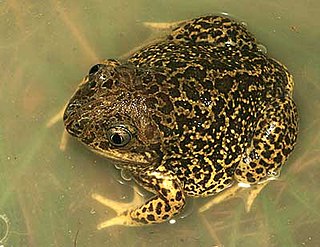
Megophryidae, commonly known as goose frogs, is a large family of frogs native to the warm southeast of Asia, from the Himalayan foothills eastwards, south to Indonesia and the Greater Sunda Islands in Maritime Southeast Asia, and extending to the Philippines. Fossil remains are also known from North America. As of 2014 it encompasses 246 species of frogs divided between five genera. For lack of a better vernacular name, they are commonly called megophryids.
Atympanophrys is a genus of frogs in the family Megophryidae. They range from central China south to northern Vietnam. They are commonly known as hidden-tympanum horned toads.

Amolops is a genus of true frogs native mainly to eastern and south-eastern Asia. These frogs are closely related to such genera as Huia, Meristogenys, Odorrana, Pelophylax and Rana, but still form a distinct lineage among the core radiation of true frogs. They are commonly known as "torrent frogs" after their favorite habitat - small rapid-flowing mountain and hill streams - but this name is used for many similar-looking frogs regardless of whether they are loosely related.

Xenophrys glandulosa, the glandular horned toad or Jingdong spadefoot toad is a species of amphibian in the family Megophryidae found in Yunnan in China, in Nagaland in northeastern India, and in northern Kachin State, Myanmar. It has recently been reported from Bhutan. Its type locality is Mount Wuliang in Jingdong County, Yunnan. Its natural habitats are tropical moist montane forests and rivers.

Scutiger is a genus of toads in the family Megophryidae. Common name lazy toads has been coined for them. They occur in China, Burma, Nepal, and northern India in high-altitude habitats. Most are endemic to China.

Xenophrys aceras, commonly known as the Perak horned toad, Perak spadefoot toad or Malayan horned frog, is a species of frog in the family Megophryidae found in Peninsular Malaysia and Thailand, and possibly in Indonesia. Its common name refers to its type locality, Bukit Besar in Perak state, Malaysia.

The Kinabalu horned frog or Balu spadefoot toad is a species of amphibian in the family Megophryidae. It is endemic to northeastern Borneo in Sabah, Malaysia. Its natural habitats are subtropical or tropical moist montane forests and rivers.

Xenophrys longipes is a species of frog in the family Megophryidae. It is also known as the Malacca spadefoot toad, red legged spine-eyed frog, red-legged horn frog, and slender-legged horned frog. It is found in the Malay Peninsula. Records from Cambodia and Vietnam are considered doubtful.
The Mangshan horned toad, or Mangshan spadefoot toad, is a species of frog in the family Megophryidae. It is endemic to China and known only from southern Hunan and northern Guangdong; its type locality is Mount Mang (Mangshan) in Yizhang County, Hunan. Its natural habitats are subtropical or tropical moist lowland forests, subtropical or tropical moist montane forests, and rivers. It is threatened by habitat loss.
The Medog horned toad, or Medog spadefoot toad, is a species of frog in the family Megophryidae. It was described as a subspecies of Omei horned toad based on specimens collected from Mêdog County, Tibet (China); it is still only known from its type locality. It probably has a wider distribution that may reach India. Its natural habitats are subtropical or tropical moist lowland forests, subtropical or tropical moist montane forests, and rivers.
The convex-vented horned toad, also known as the Gelin spadefoot toad or Huang's spadefoot toad, is a species of frog in the family Megophryidae. It is found in Tibet (China) and northern Vietnam, and possibly in India. Its natural habitats are subtropical or tropical moist montane forests and rivers.
Zhang's horned toad, or Zhang's spadefoot toad, is a species of frog in the family Megophryidae. It is found in Zhangmu, Nyalam County, Tibet, China . Its natural habitats are temperate forests and rivers.

The Pelobatoidea are a superfamily of frogs. They typically combine a toad-like body shape with a frog-like, pointed face. Phylogenetically they stand between primitive frogs on the one side and higher frogs on the other and are therefore – among other things by characteristics of bone construction – in the suborder Mesobatrachia.
Xenophrys damrei is a species of megophryid toad endemic to Cambodia. It is only known from its type locality, Bokor Plateau in the Dâmrei Mountains of southern Cambodia. The species description was published in 2011 but was based on samples collected by Malcolm Arthur Smith in 1914. The species has not been observed in surveys ever since, although this might reflect seasonal variability. The known specimens measure 69 mm (2.7 in) and 57 mm (2.2 in) in snout–vent length.
Xenophrys megacephala is a species of frog in the family Megophryidae from East Khasi Hills District, Meghalaya, India.
Xenophrys takensis, also known as the Tak horned toad, is a species of frog in the family Megophryidae from Tak Province, Thailand.

Boulenophrys is a genus of frogs in the family Megophryidae. They occur in the China, Mainland Southeast Asia and Northeast India. It had been placed variously as a subgenus or synonymy of Megophrys. Dubois, Ohler and Pyron first recognized that Panophrys is preoccupied and employed Boulenophrys as the generic name rather than Tianophrys under the Principle of First Revisor.

Pelobatrachus is a genus of frogs in the family Megophryidae. It was formerly synonymized with Megophrys until 2021, when it was revived as a distinct genus. They inhabit Southeast Asia, namely the Malay Peninsula, Sumatra, Borneo and the Philippines. Their common name is clay horned toads.
Xenophrys awuh, the Naga hills horned frog, is a species of frog belonging to the Xenophrys genus. It is found in an elevation range of 1,650 to 2,220 m. It is endemic to India and Myanmar, and was first described in 2020.











